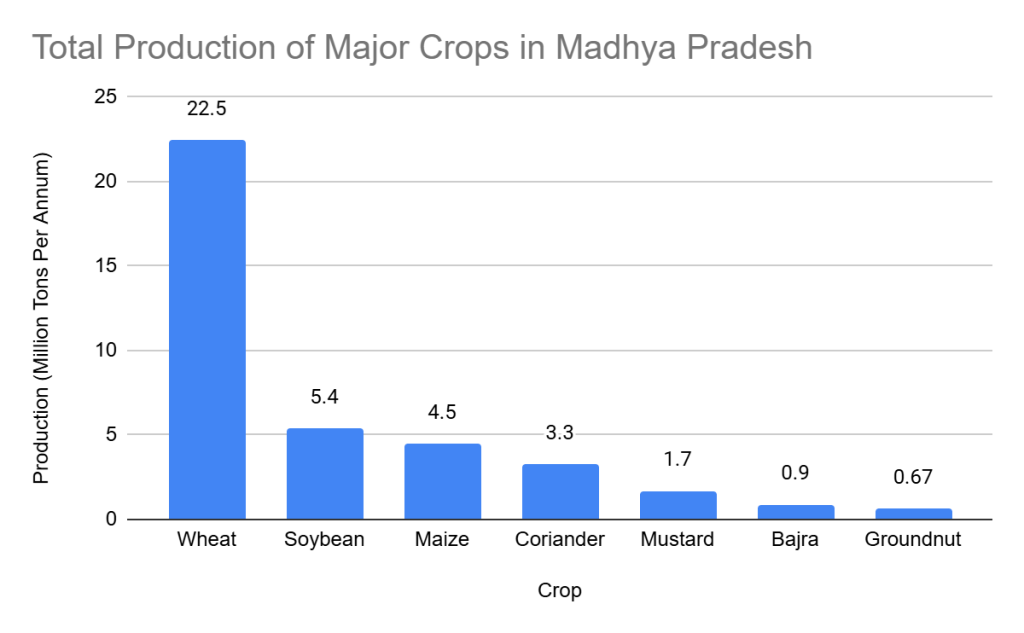
Key Questions Answered in this Section
- What are the major crops contributing to biomass feedstock production in Madhya Pradesh?
- Which regions in Madhya Pradesh are known for cultivation of prominent crops?
- Which types of biomass residues are generated in Madhya Pradesh?
- What are the biomass clusters in Madhya Pradesh?
- How is the biomass supply chain in Madhya Pradesh?
- How much wheat straw is generated in Madhya Pradesh?
- How much soybean stalk is generated in Madhya Pradesh?
- How much maize corn and husk is generated in Madhya Pradesh?
- How much coriander stalk is generated in Madhya Pradesh?
- How much mustard stalk is generated in Madhya Pradesh?
- How much bajra stalk is generated in Madhya Pradesh?
- How much groundnut shells is generated in Madhya Pradesh?
Madhya Pradesh comprises a mix of urban and rural regions, with the top urban areas being Indore, Bhopal, Jabalpur, Gwalior, Ujjain, Sagar, Dewas, Satna, Ratlam, and Rewa. Understanding the biomass supply chain in Madhya Pradesh is crucial for optimizing the utilization of agri residues and enhancing the state’s bioenergy potential.
Major Crops Grown
| Crop | Production (Million Tons Per Annum) |
| Wheat | 22.5 |
| Soybean | 5.4 |
| Maize | 4.5 |
| Coriander | 3.3 |
| Mustard | 1.7 |
| Bajra | 0.9 |
| Groundnut | 0.67 |

The cultivation of these crops results in substantial biomass feedstock, contributing significantly to Madhya Pradesh’s bioeconomy.
Residue Generation
| Crop | Residue Parts | Production (Million Tons) |
| Wheat | Straw | 17 |
| Soybean | Stalk | 2.43 |
| Maize | Corn, husk | 2.25 |
| Coriander | Stalk | NA |
| Mustard | Stalk | NA |
| Bajra | Stalk | NA |
| Groundnut | Shells | 0.2 |

Efficient management of these crop residues is essential for developing a sustainable biomass supply chain in Madhya Pradesh.
Significant Regions of Availability
- Soybean: Ujjain, Hoshangabad, Guna, Indore, Sagar, Rajgarh
- Maize: Chhindwara, Seoni, Betul, Barwani, Dhar
- Coriander: Guna, Rajgarh, Mandsaur, Agar-Malwa, Neemuch
- Mustard: Morena, Gwalior, Shivpuri
- Bajra (Millet): Malwa
- Groundnut: Khargone, Badwani, Chhindwada, Seoni, Betul, Datiya, Shivpuri, Tikamgarh, Chhatarpur
- Wheat: Sehore, Narsinghpur, Narmadapuram, Hoshangabad, Harda, Ashoknagar, Bhopal and Malwa regions.
Identifying these biomass clusters enables targeted strategies for biomass feedstock collection and utilization.

Prominent Crops in Different Regions of Madhya Pradesh
Each region’s unique crop profile contributes to the diversity of agricultural residues, impacting the overall biomass availability in Madhya Pradesh.
| Region | Prominent Crops |
| Ujjain | Soybean |
| Hoshangabad | Soybean, Wheat |
| Guna | Soybean, Coriander |
| Indore | Soybean |
| Sagar | Soybean |
| Rajgarh | Soybean, Coriander |
| Chhindwara | Maize, Groundnut |
| Seoni | Maize, Groundnut |
| Betul | Maize, Groundnut |
| Barwani | Maize, Groundnut |
| Dhar | Maize |
| Mandsaur | Coriander |
| Agar-Malwa | Coriander |
| Neemuch | Coriander |
| Morena | Mustard |
| Gwalior | Mustard |
| Shivpuri | Mustard, Groundnut |
| Malwa | Bajra (Millet), Wheat |
| Khargone | Groundnut |
| Badwani | Groundnut |
| Datiya | Groundnut |
| Tikamgarh | Groundnut |
| Chhatarpur | Groundnut |
| Sehore | Wheat |
| Narsinghpur | Wheat |
| Narmadapuram | Wheat |
| Harda | Wheat |
| Ashoknagar | Wheat |
| Bhopal | Wheat |
Utilization of Crop Residues at the Farmer’s Level in Madhya Pradesh
- Essential Usage for Livestock and Fertilizer
- Residues from Maize, Jowar, and Urad are extensively used for cattle feeding.
- Parts of residues from Soybean, Paddy, and Wheat are also used as cattle feed.
- Residues from crops such as Bajra, Bengal Gram, Groundnut, Jowar, Masoor, and Urad are commonly utilized for preparing compost fertilizers.
- Specific Usage in Industrial Applications
- Crop residues like Soybean and Wheat are predominantly sold to brick kilns and briquetting plants for industrial uses.
- Fuel Usage for Domestic Needs
Stalks of Arhar, Cotton, Paddy, and Wheat are widely used as fuel for household cooking. - Field Preparation through Residue Burning
Burning of stubbles from Paddy, Urad, and Wheat is a widespread practice to prepare fields for the next sowing cycle. - Commercial Applications
Farmers earn additional income by selling crop residues to briquetting or biomass plants, contributing to the economic value of agricultural byproducts.

